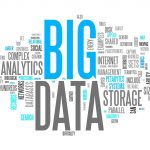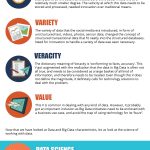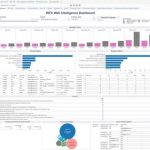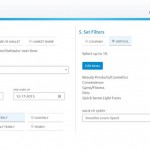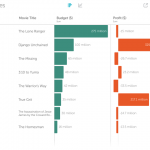Human instinct Vs. advertising information: Forging a new Alliance
Human instinct and knowledge don’t need to be at odds with one every other. Columnist Joshua Reynolds explains why one of the best advertising analytics solutions make use of both thoughts and computing device.

As advertising analytics proceed to adapt at a breakneck p.c., a fascinating race is beginning to take form: human intuition vs. computing device-based intelligence.
previous this month, MIT researchers introduced they’ve developed an algorithm that may trump human instinct. The “data vs. instinct” debate also popped up in a couple of periods finally month’s promotion Week in the big apple, and it has been a routine theme for years.
however in some ways, the battle between human instinct and machine data is a false one. the real answer lies in altering the way humans have interaction with machines, and designing this new alliance is particularly necessary for entrepreneurs.
instinct Is knowledge
There’s one interesting part of this “humans vs. machines” analytics discussion that isn’t addressed regularly, and that’s the truth that the human mind remains some of the flexible and powerful sources of computing on this planet.
instinct is information. It’s simply that human intuition is processed within the ultimate black box algorithm — the human brain — and none of us personal the IP on that (at least not but).
The human mind, uniquely designed to to find that means in shapes and visual patterns, engages with desktop information thru information visualization. desktop knowledge, when it’s at its most efficient, combines excessive-finish computations with intuitive and fascinating data visualizations.
And probably the greatest advertising and marketing analytics solutions are those who acknowledge that human intuition — and possibly most importantly, human curiosity — plays a essential position in moving from data to perception to resolution to motion.
in the end, human curiosity is nothing greater than an organically information-driven impulse that something is price further investigation. And human intuition is simply an organically information-driven conclusion that for causes we won’t be able to articulate, a correlation exists that we ought to take a look at to be aware further.
That’s why in lots of information scientist circles, together with right here at Quantifind (my supplier), people are beginning to espouse the realization that relatively than focusing exclusively on AI, or artificial intelligence, we must be excited by IA, or intelligence augmentation.
this allows us to go deeper with our instinct and expose our instincts to new inspirations. data visualizations open up complete new worlds of potentialities for the human thoughts to react to and process.
in brief, marketers must be looking for options that let them tap into their curiosity and instincts.
They will have to look for features that assist them explore and keep in mind their information better. They will have to be the usage of each thoughts and computer to analyze the correlations that matter between what marketing is doing, what clients are announcing and the way their industry is performing.
and thru it all, they must are seeking to redesign the alliance between human intuition and desktop-driven information. however to do so requires that we rethink what data does and doesn’t do.
Algorithms Are tools, not finish-To-finish options
To be clear, the MIT analysis is superb information science. at present, people are significantly better than machines at settling on promising patterns in large knowledge units.
that is, people define fascinating issues, then use these definitions to create instructing sets for machine studying. This process has made algorithms a outcome of instinct.
MIT’s venture, referred to as the info Science desktop, probably adjustments this dynamic, picking out meaningful patterns without human guidance. In knowledge science competitions, the MIT algorithm didn’t beat all human adversaries, however it beat most of them and labored exponentially sooner.
obviously, the research has a place. it’s going to play a role in future advances and can extend the duties that machines can also be anticipated to reliably complete.
however like most know-how, any such strengthen is a software — just right at some things, suspect at others.
To their credit score, the MIT researchers recognize these boundaries. “We view the info Science computer as a natural complement to human intelligence,” Max Kanter, whose MA thesis was the basis for the algorithm, informed MIT information.
entrepreneurs want to take a in a similar way measured manner. Neither knowledge nor inventive instinct alone is a full-fledged resolution.
the key to success will be marrying the 2 strategies, because of this that slightly than shopping for into hype and treating data as omniscient, marketers want to acknowledge the boundaries of various methods.
the data Science machine, as an example, at the moment works with relational databases — that is, the kind of structured data we regularly see in spreadsheets but now not the unstructured, chaotic information generated by way of one thing like social media.
this type of relational prognosis has clear advantages and bounds. The researchers illustrate that if a database contains beginning and finish dates for more than a few gross sales campaigns and weekly profits, “the crucial information will not be the dates themselves however the spans between them, or not the entire income but the averages across those spans.”
That’s true sufficient. general profit may well be much less necessary than some development that causes quick-term sales spikes, for example.
selecting this trend and figuring out tips on how to scale it throughout longer sessions is extra precious than seeing cumulative figures. As a software with strengths and weaknesses, the information Science machine may be best for this type of work.
Unstructured information is totally different. Social media comments don’t fit into relation spreadsheets. they may be able to’t be mined for meaningful correlations using the same techniques that work in a structured database.
as an example, when movie show internet sites crashed this month right through the frenzy for big name Wars tickets, many commentators ironically commented on social media — e.g., “Fandango, load or load no longer, there is not any are trying.” For an algorithm, it’s troublesome to recognize that this kind of remark is a sarcastic criticism that could, if extensively shared, have implications for the logo’s recognition.
For a person armed with instinct and experience, on the other hand, the connection is apparent.
Human Curiosity And Creativity Will all the time subject
ingenious interpretation of the data is always going to be very important. A marketer may use something like the info Science machine for some duties while counting on a distinct set of algorithms and methodologies for different duties.
When confronted with unstructured social data, for instance, the marketer could correlate social comments to earnings. this is able to let the marketer to identify consumer language patterns that correlate with gross sales boom and to tailor messaging to the subjects expressed in these patterns.
but even then, this “tailoring” received’t be an automatic process.
What’s more, only human instincts can assist resolve what questions are worth pursuing within the first position. the only thing worse than the wrong answer is the right solution to the mistaken query. And best human discernment can inform the variation.
discovering a option to force revenue that works most effective in idea is useless if it doesn’t also work politically, organizationally and psychologically for all the determination-makers concerned.
ultimately, then, entrepreneurs should ask themselves a few vital questions as they way their advertising knowledge solutions:
- what’s the present relationship between my own subjective marketing instincts and my data answer? How do i would like that relationship to alter?
- Who determines what questions I discover — the laptop, me, or a mix of each? And who’s better put to understand what questions lead to more revenue upside?
- where within the process have we accounted for political and organizational realities? Have we reverse-engineered our insights process to find answers that are not handiest precious but in addition very nearly actionable?
- lastly, how does the information lead me to raised, more fruitful questions to discover, and what room does this process depart for the serendipitous discovery of unexpected income opportunities?
Some opinions expressed in this article could also be these of a guest creator and now not necessarily advertising Land. group of workers authors are listed right here.
(Some pictures used underneath license from Shutterstock.com.)
advertising and marketing Land – web advertising and marketing information, strategies & tips
(105)




